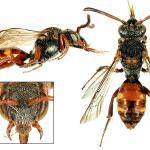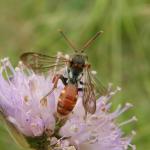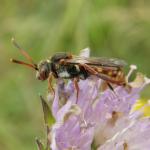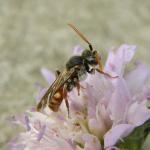Nomada rostrata Lepeletier, 1841; Nomada lanceolata Lepeletier, 1841; Nomada compta Lepeletier, 1841; Nomada kirbyella Stephens, 1846; Nomada cincticornis Nylander, 1848.
Certain Nomada species visit the same restricted flower species as those of their host bees. One such species is N. armata, which largely confines its flower visits to two species of scabious (see below).
Very rare and apparently declining, with the most recent records from near Oxford (in 1974) and a few sites on Salisbury Plain, Wiltshire (since 1991; see Else & Roberts, 1994). Formerly recorded widely in southern England and south Wales. There are no Irish records of this species. Uncommon but widely distributed in Europe, the range extending from southern Finland to the south of France.
Listed as Endangered (RDB1) in Shirt (1987), a status with which Falk (1991) agrees. In view of recent findings from Salisbury Plain, the status may need revision.
Mainly open grassland, flying with its host bee, Andrena hattorfiana. The Nomada, however, is considerably rarer than the Andrena.
Univoltine; late June to early August.
A cleptoparasite of the mining bee Andrena hattorfiana (Bridgman, 1879; Hamm, 1901; Perkins, 1919, 1924). Females of this Nomada have been observed flying around the nesting burrows of the host bee (Else & Roberts, 1994).
Field scabious (Knautia arvensis) and small scabious (Scabiosa columbaria). The bee has been swept from red bartsia (Odontites vernus) flowers (G M Spooner, pers. comm.).
None reported.
Profile written: 2001
Proofed: February 2012





